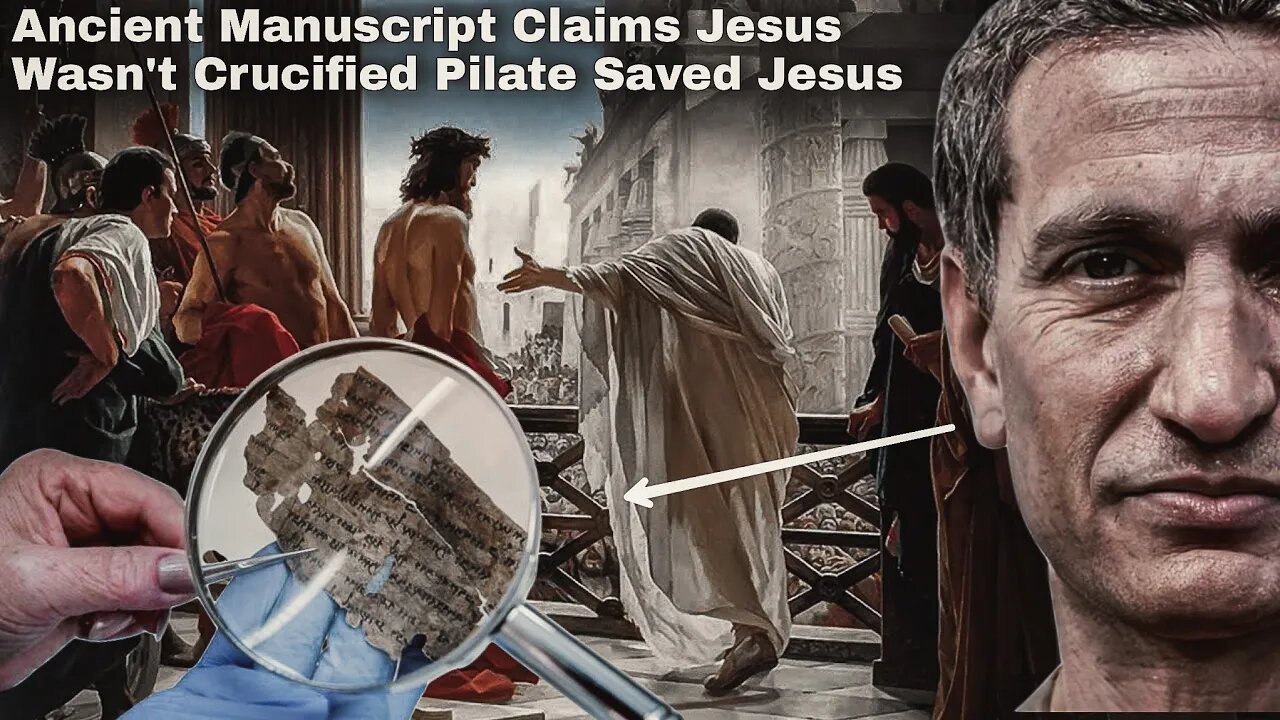Premium Only Content

1200 year old Mysterious Ancient Manuscript Claims Jesus Wasn't Crucified
1.200 years old Ancient Manuscript Claims Jesus Wasn't Crucified | Pilate Saved Jesus
A nearly 1,200-year-old Egyptian document that has just been decoded relates a portion of the account of Jesus' crucifixion with apocryphal plot turns, some of which have never been seen before,
You've heard of Jesus, right? God's Son, born in Bethlehem, skilled with fish and wine for blood? He was a nice man who could do a lot of interesting things. One of the fascinating things he could do, according to this strange ancient Egyptian literature, was shape-shift.
A portion of Jesus' crucifixion account is told in a 1,200-year-old Egyptian document with apocryphal plot changes, some of which have never been seen before. The ancient document, which was written in the Coptic language, describes Pontius Pilate, the magistrate who approved Jesus' crucifixion,
having dinner with Jesus the night before he was crucified, and offering to offer his own son as a sacrifice in Jesus' stead. Because Jesus possessed the power to change shape, according to the Bible, it also explains why Judas used a kiss to betray him. Additionally, it moves forward Jesus' arrest day from Thursday evening to Tuesday evening, which is in conflict with the Easter date,
According to Roelof van den Broek of Utrecht University in the Netherlands, who published the translation in the book "Pseudo-Cyril of Jerusalem on the Life and the Passion of Christ," the text's discovery does not imply that these occurrences actually took place, but rather that some people who were present at the time seem to have believed in them.
Two manuscripts, one at the Museum of the University of Pennsylvania and the other at the Morgan Library and Museum in New York City, have copies of the text. Due to the Pennsylvania manuscript's mainly unreadable pertinent material, most of the translation is taken from the New York version,
Pontius Pilate has dinner with Jesus,
Although there are other apocryphal tales about Pilate that date back to antiquity, van den Broek claimed in an email to LiveScience that he had never before come across the one in which Pilate offered to sacrifice his own son in place of Jesus,
“Without further ado, Pilate prepared a table and he ate with Jesus on the fifth day of the week. And Jesus blessed Pilate and his whole house,” reads part of the text in translation. Pilate later tells Jesus, “well then, behold, the night has come, rise and withdraw, and when the morning comes and they accuse me because of you, I shall give them the only son I have so that they can kill him in your place.”
Oh, Pilate, you have been found worthy of a great favor since you have shown a kind disposition to me, Jesus says as he consolingly addresses him in the passage. Jesus again demonstrated to Pilate that he might flee if he so desired. Pilate observed Jesus at that point and noticed that he had transformed into an incorporeal form,
That evening, Pilate and his wife both see visions of an eagle being slain in remembrance of Jesus. According to van den Broek, Pilate is revered in the Coptic and Ethiopian churches, which explains the text's favorable picture of him,
The reason for Judas using a kiss.
According to the canonical Bible, Judas the apostle betrays Jesus in return for money by kissing him and identifying him, which causes Jesus to be arrested. According to this legendary story, Jesus could change shapes, which is why Judas used a kiss in particular.
The Jews then asked Judas, "How will we capture him (Jesus), for he has no one shape, but alters his appearance. He is occasionally ruddy, occasionally white, sometimes red, occasionally wheat-colored, occasionally pale like ascetics, occasionally a young guy, occasionally an elderly man. Judas suggests using a kiss to recognize him as a result of this. Judas might have assumed a different form if he had provided the arresting officers with a description of Jesus. Judas exposes himself to the public by kissing Jesus.
This knowledge of Judas' kiss dates back a long time. According to van den Broek, "Origen (a theologian who flourished from A.D. 185 to 254) is where this account of Judas' kiss is first discovered." The ancient author Origen said in his work "Contra Celsum" that "to those who saw him (Jesus), he did not seem similar to everyone."
religious history
religious history documentary
bible documentary
Jesus documentary
secrets of Christianity 101
secrets of Christ's tomb national geographic
secrets of Christianity
another messiah
was Jesus real
Jesus christ archaeology
Jesus tomb archaeology
archeology Jesus tomb
Jesus' nails found
Jesus voyage
Jesus life
the lost gospel
-
 0:28
0:28
MindSet Code Ph
2 years ago $0.09 earnedGuarantee Goosebumps
1.05K1 -
 9:43
9:43
MattMorseTV
1 day ago $18.71 earnedTulsi just DROPPED a BOMBSHELL.
76.6K97 -
 2:21:13
2:21:13
Tundra Tactical
6 hours ago $0.11 earned"The World's Okayest Gun Live Stream: Reloading Series Announcement & ATF Pistol Brace is Dead
630 -
 11:49
11:49
Nikko Ortiz
1 day agoCrazy Instant Karma Clips
53.2K25 -
 49:34
49:34
TruthStream with Joe and Scott
18 hours agoEllen P Lincoln interviews Joe: A deep dive into his history and background. Premiers 7/19
10K1 -
 LIVE
LIVE
Lofi Girl
2 years agoSynthwave Radio 🌌 - beats to chill/game to
862 watching -
 20:14
20:14
GritsGG
13 hours agoHackers vs Win Squad! Let's Get it Done!
5.16K -
 59:26
59:26
Omar Elattar
9 months agoFrom HEROIN To CEO: How I Overcame Addiction & Built A $120k/Month Business
3.88K1 -
 26:18
26:18
Stephen Gardner
10 hours ago🔥YES! Trump makes TWO HUGE moves on Epstein!!
23.7K53 -
 1:58:25
1:58:25
Badlands Media
14 hours agoDevolution Power Hour Ep. 373: Narrative Whiplash, Border Theater, and the Trump Time Bomb
84K39